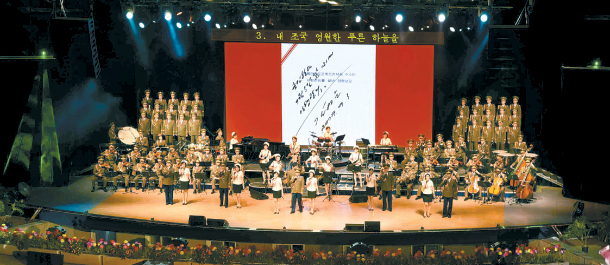Pyongyang prepares for next nuclear test

The North Korean state-run musical band and choir hold concerts in Wonsan on Wednesday with a backdrop of the handwritten order by North Korean leader Kim Jong-un to conduct a hydrogen bomb test. Rodong Sinmun, the official newspaper of North Korea’s Workers’ Party, published the photo on Thursday’s front page. [YONHAP]
Citing imagery from the Punggye-ri Nuclear Test Site in Mount Mantap, where the country conducted all six of its nuclear experiments, the North Korean monitoring website, which is run by the U.S.-Korea Institute at Johns Hopkins University’s School of Advanced International Studies, wrote Tuesday that “a large tractor and trailer cargo truck” were seen near the south portal for the first time on Sept. 8, and “mining carts and other equipment” were noted outside the west portal.
Such activity, which comes shortly after North Korea carried out its latest nuclear test at the north portal on Sept. 3, “suggests that on site work could now be changing focus to further prepare those other portals for future underground nuclear testing.”
This is the first time in over a year that any of such movement was detected near the south portal, the report said.
The 38 North analysis was by Frank V. Pabian, a retired Los Alamos National Laboratory fellow; Joseph S. Bermudez Jr., a North Korean defense and intelligence affairs expert; and Jack Liu, a longtime contractor for the U.S. Department of Defense.
It also said there appeared to be increased water drainage in the north portal area, likely caused by the recent nuclear test.
“Such underground water flow stimulation,” which is brought about by the expansion of existing cracks and fissures, “could also be expected to promote the transport of radionuclides to the surface,” and is consistent with South Korea’s report of recently detected Xenon-133.
Further damage was noted by nuclear expert Jeffrey Lewis, who wrote Wednesday on Arms Control Wonk, an arms control blog network, that the height of Mount Mantap shrank after the sixth nuclear test, though he did not say by how much. Lewis’s analysis was based on radar imagery.
The mountain, which was previously 2,205 meters (7,234 feet) high, has incurred a “visible amount of subsidence” at its peak, and over 85 acres of its southwest flank was displaced by several meters.
If the explosion occurred beneath this area, it could mean that the yield of the bomb was over 300 kilotons, said Lewis.
As with all previous detonations, the yield of North Korea’s sixth nuclear test is not precisely known.
Pyongyang has not mentioned a figure, while South Korea’s military predicted it to have been 50 kilotons, or equal to about 50,000 tons of TNT.
Norwegian Seismic Array, or Norsar, and Japan’s military both placed the number at 120 kilotons, while a group of scientists at China’s University of Science and Technology estimated it at 108.3 kilotons.
BY LEE SUNG-EUN [lee.sungeun@joongang.co.kr]










with the Korea JoongAng Daily
To write comments, please log in to one of the accounts.
Standards Board Policy (0/250자)